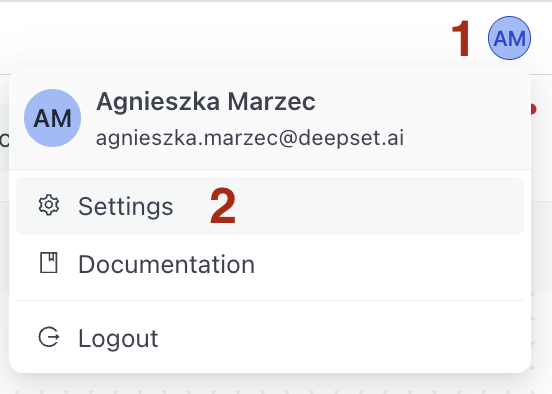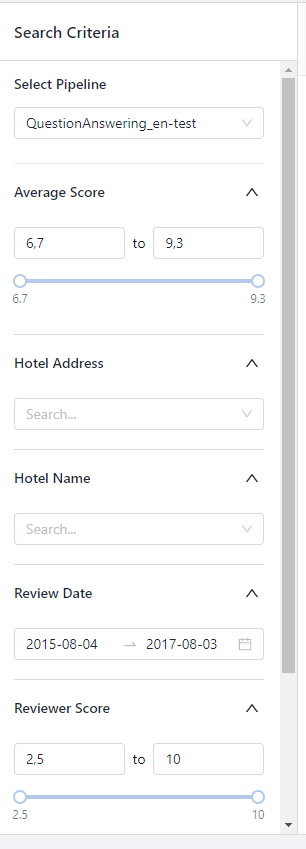Tutorial: Uploading Files with Metadata through SDK CLI
Learn to quickly upload large amounts of files with metadata. In this tutorial, you'll upload a set of hotel reviews but you can replace these files with your own. You will use the SDK package with a command-line.
- Level: Beginner
- Time to complete: 10 minutes
- Prerequisites:
- You must be an Admin to complete this tutorial.
- The workspace where you want to upload the files must already be created in deepset AI Platform. In this tutorial, we call the workspace hotel_reviews.
- Goal: After completing this tutorial, you will have uploaded a set of hotel reviews with metadata to a deepset workspace. You can replace this dataset with your custom one.
Prepare Your Files
This tutorial uses a set of hotel reviews with some metadata in them. You can also use your own files. Make sure their extensions are lowercase, for example:_ myfile.txt_ instead of myfile.TXT.
- Download the hotel reviews dataset.
- Extract the files to a folder called hotel_reviews in your Documents folder. This can take a couple of minutes.
Result: You have 5,956 files in the \Documents\hotel_reviews folder, 2978 TXT files and 2978 JSON files. Each TXT file is accompanied by a .meta.json file containing the text file metadata.
Install the SDK
- Open the command line and run:
pip install deepset-cloud-sdk - Wait until the installation finishes with a success message.
Result: You have installed the deepset SDK. It comes with a command line interface that we'll use to upload the files.
Obtain the API Key
- Log in to deepset AI Platform.
- Click your profile icon in the top right corner and choose Settings.

- Go to Workspace>API Keys.
- Under API Keys, click Create API key.
- Configure the key:
- Choose Personal Key.
- Type "tutorial" as the key name.
- Set the expiration date to the end of the month.
- Choose the workspace where you want to upload the files.
- Choose the role to determine the key's permissions. It should be at least Editor.
- Click Create API key.
- Copy the key and save it to a notepad.
Result: You have an API key saved in a file. You can now use it to upload your files.
Upload Files
- Open the command line and run the following command to log in to deepset AI Platform:
deepset-cloud loginpython -m deepset_cloud_sdk.cli login - When prompted, paste your API key.
- Type the name of the deepset workspace where you want to upload the files. This creates an .env file with the information you just provided. The SDK uses the information from this file when uploading files.
- Run this command to upload files, including all the subfolders of the hotel_reviews folder and overwrite any files with the same name that might already exist in the workspace:
deepset-cloud upload <path_to_hotel_reviews_folder> --recursive --write-mode OVERWRITE
python -m deepset_cloud_sdk.cli upload <path_to_hotel_reviews_folder> --recursive --write-mode OVERWRITE
To upload other file types, use --desired_file_types with a list of file types, for example: --desired_file_types ['.csv', '.html']\.
- Wait until the upload finishes successfully. You should see this message:

5956 files are uploaded, and half of them, 2978 are listed in deepset AI Platform. (The metadata files are not shown in deepset).
Result: You have uploaded all your files, including the ones from the subfolders. Let's now see if they're showing up in deepset.
Verify the Upload
-
In the command line, list the uploaded files by running:
deepset-cloud list-filespython -m deepset_cloud_sdk.cli list-filesYou should see a list of files with file ID, URL, name, size, metadata, and the date when it was created.

With the number of files we uploaded, it's easier to verify if they uploaded correctly in the deepset UI.
-
You can also check it in deepset. Click the workspace name to switch to the workspace where you uploaded the files, and choose Files in the navigation. You should see all the uploaded files on the Files page.
-
Now, let's check if the metadata was uploaded.
-
One way to do this is to open a random file and then click View Metadata on the file preview.
-
Metadata appears as search filters, so let's check if that's the case. You need a pipeline to run a search, so if you don't have one in this workspace, let's quickly create one:
- Go to Pipeline Templates, click Basic QA, and choose Retrieval Augmented Generation Question Answering Llama2-13b.
- Type QuestionAnswering_en-test as the pipeline name and create the pipeline. You're redirected to the Pipelines page with your pipeline listed in the In Development section.
- Click **Deploy **next to the pipeline and wait until your pipeline is indexed.
- When the pipeline is indexed, click Playground.
- Choose your pipeline, and you'll see all the metadata now available as search criteria:

-
Was this page helpful?